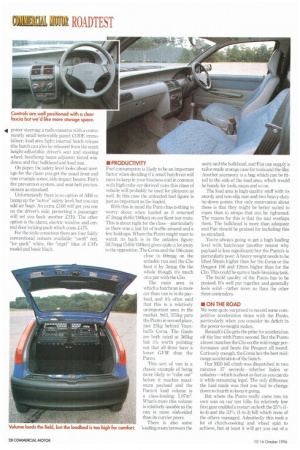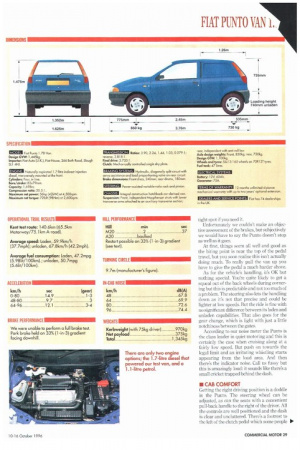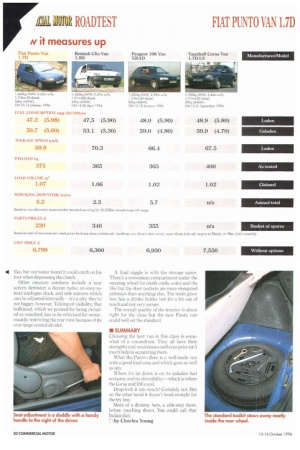1\1
Page 29

Page 30

Page 31

Page 32

If you've noticed an error in this article please click here to report it so we can fix it.
SPA The Fiat Punto Van comes highly recommended: "European car of the year!" screamed the car journalists back in 1995 when the Punto 55S car was launched. But hang on a minute, what about the competitive world of the commercial vehicle, where payload and fuel economy count for everything?
On the other hand it's an old question whether the hatchvan counts as much of a commercial vehicle in the first place. After all, it's really just a car with the rear windows replaced by steel and the hack seats taken out.
But either way, the fact is that Punto is claiming to be a van in this guise and a great car does not necessarily make a great van.
CM has driven some extremely competent examples of the hatch-derived van in recent years and the market is highly competitive: first there are the two Gallic contributions, Peugeot's easy-to-drive 106 and Renault's great value Clio. Then you've got the fuel-conscious Vauxhall Corsa—also good value. Add to these Ford's revamped Fiesta in van form, which promises to be a strong contender (watch out for a test soon) and the playing field becomes a pretty tough one. So will the Punto be placed in the lead or will we have to • PRODUCT PROFILE
Apart from taking the seats out and replacing 8 glass with steel, Fiat has added a bulkhead (lower half steel; top half plastic mesh), two tie-down hooks, and a PVC-covered plywood load mat to complete the van transformation.
These things aside, the van looks identical to the car—and that includes the rear bumper which passes for an oversized mud flap.
For some reason the steel that's replaced the windows has a groove running round the inside and this is a shame as it could interfere with an owner's logo or advertising potential.
In line with other manufacturers Fiat has kept the Punt() range simple. Only two options are available: the 55 1.1-litre petrol and our test model, the 1.7-litre diesel. For £299 more than the petrol option, the diesel offers the same payload and an extra 3hp. But as its (iVW is greater there is likely to be little difference in their performance.
On the face of it this suggests the Punto may be under-powered. All the competition has more power except the 106, which is also rated at 56hp but has a lighter GVIN. Renault's Clio has nine more horses and is some 100kg lighter when fully laden.
The specification level of the Punto is pretty good. For the basic price of £6,799 you get power steering; a radio-cassette with a conveniently small removable panel; CODE immobiliser; load-area light; internal hatch release (the hatch can also he released from the rear); height-adjustable driver's seat and steering wheel; headlamp beam adjuster; tinted windows; and that bulkhead and load mat.
On paper, the safety level looks about average for the class: you get the usual front and rear crumple zones, side impact beams, Fiat's fire prevention system, and seat-belt pre-tensioners as standard.
Unfortunately there is no option of ABS to bump up the "active" safety level, but you can add air bags. An extra £166 will get you one on the driver's side; protecting a passenger will set you back another £219. The other option is the alarm, electric window and central door locking pack which costs £475.
For the style conscious there are four fairly conventional colours available: "swift" red, "ice pack" white, the "capri" blue of (Ms model and basic black. Fuel consumption is likely to be an important factor when deciding if a small hatchvan will earn its keep in your business and in common with high-cube car-derived vans this class of vehicle will probably be used for pleasure as well. In this case the unloaded fuel figure is just as important as the loaded.
With this in mind the Punto has nothing to worry about when loaded as it returned 47.2mpg (6.01it/100km) on our Kent test mute. This is about right for the class—particularly as there was a fair bit of traffic around and a few hold-ups. Where the Punto might want to watch its back is in the unladen figure: 50.7mpg (5.61itil 00km) gives quite a lot away to the opposition. The Corsa and the 106 came close to 60mpg on the unladen run and the Clio beat it by 3mpg. On the whole though it's much on a par with the Clio.
The main area in which a hatchvan is more car than van is in its payload, and it's often said that this is a relatively unimportant area in the market. Still, 375kg puts the Punt() in second place, just 25kg behind Vauxhall's Corsa. The Gauls are both rated at 365kg but it's worth pointing out that all three have a lower GVW than the Punto.
This sort of van is a classic example of being more likely to "cube out" before it reaches maximum payload and the Punto's load volume is a class-leading 1.07m3. What's more this volume is relatively useable as the van is more slab-sided than its curvier peers.
There is also some loading room between the seats and the bulkhead, and Fiat can supply a tailor-made storage case for tools and the like. Another accessory is a bag which can be fitted to the side of the load area, which would be handy for tools, maps and so on.
The load area is high-quality stuff with its sturdy and non-slip mat and two heavy-duty tie-down points. Our only reservation about these is that they might be better suited to ropes than to straps that can be tightened. The reason for this is that the mat overlaps them. The bulkhead is more than adequate and Fiat should be praised for including this as standard.
You're always going to get a high loading level with hatchvans (another reason why payload is less significant) but the Punto's is particularly poor. A heavy weight needs to be lifted 50rnm higher than for the Corsa or the Peugeot 106 and 12mm higher than for the Clio. This could be quite a back-breaking task.
The build quality of the Punto has to be praised. It's well put together and generally feels solid—rather more so than the other three contenders.
• ON THE ROAD
We were quite surprised to record some competitive acceleration times with the Punto, particularly when you consider its deficit in the power-to-weight stakes.
Renault's Clio gets the prize for acceleration off the line with Punto second. But the Punto almost matches the Clio on the mid-range performance and beats the Peugeot all round. Curiously enough, the Corsa has the best midrange acceleration of the bunch.
Our M20 hill climb was dispatched in two minutes 37 seconds—whether laden or unladen—which is about as fast as you can do it while remaining legal. The only difference the load made was that you had to change down to fourth to keep it going.
But where the Punto really came into its own was on our test hills. Its relatively low first gear enabled a restart on both the 25% (1in-4) and the 33% (1-in-3) hill which none of the others managed. Admittedly this took a lot of clutch-cooking and wheel spin to achieve, but at least it will get you out of a
tight spot if you need it.
Unfortunately we couldn't make an objective assessment of the brakes, but subjectively we would have to say the Punto doesn't stop as well as it goes.
At first, things seem all well and good as the biting point is near the top of the pedal travel, but you soon realise this isn't actually doing much. To really pull the van up you have to give the pedal a much harder shove.
As for the vehicle's handling, it's OK but nothing special. You're quite likely to get a squeal out of the back wheels during cornering but this is predictable and not too much of a problem. l'he steering also lets the handling down as it's not that precise and could be lighter at low speeds, But the ride is fine with no significant difference between its laden and unladen capabilities. That also goes for the gear change, which is light with just a little notchiness between the gates.
According to our noise meter the Punto is the class leader in quiet motoring and this is certainly the case when cruising along at a fairly low speed. But push on towards the legal limit and an irritating whistling starts appearing from the load area. And then there's the indicator noise. Call us fussy but this is amazingly loud: it sounds like there's a small cricket trapped behind the dash.
• CAB COMFORT Getting the right driving position is a doddle in the Punta The steering wheel can be adjusted, as can the seats with a convenient pull-back handle to the right of the driver. All the controls are well positioned and the dash is clear and uncluttered. There's a footrest to the left of the clutch pedal which some people Po like, but our tester found it could catch on his foot when depressing the clutch.
Other creature comforts include a rear screen demister; a decent radio; an easy-toread analogue clock, and side mirrors which can be adjusted internally —it's a pity they're not bigger, however. Talking of visibility, that bulkhead, which we praised for being included as standard, has to be criticised for unnecessarily restricting the rear view because of its over-large central divider. A final niggle is with the storage space. There's a convenient compartment under the steering wheel for credit cards, coins and the like but the door pockets are more elongated ashtrays than anything else. The main glove box has a drinks holder but it's a bit out of reach and not very secure.
The overall quality of the interior is about right for the class but the new Fiesta van could well set the standard.
Choosing the best van in this class is somewhat of a conundrum. They all have their strengths and weaknesses and even price isn't much help in separating them.
What the Junto offers is a well-made van with a good load area and which goes as well as any Where it's let down is on its unladen fuel economy and its driveability—which is where the Corsa and 106 excel.
Drop-kick it into touch? Certainly not. But on the other hand it doesn't head straight for the try line.
More of a dummy here, a side-step there, before touching down. You could call that Italian flair.
El by Charles Young
























































































































